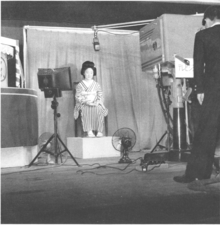441-line television system
[1] After trials with a 375-line system during the Berlin Olympic Games of 1936, by 1937 Germany had introduced a 441-line with 50 interlaced fields per second television system that replaced the previous 180 lines network relayed by a special Reichspost (National Post Office) cable network in the country's main cities (Berlin, Hamburg, Munich, Bayreuth, Nuremberg).
A project began in 1938 involving the National Post and several companies including Bosch, Blaupunkt, Loewe,[5] Lorenz, TeKaDe [de][6] and Telefunken[7][8] that aimed to produce 10,000 receivers for the television system.
The transmitter's aerials in Berlin were destroyed during an Allied Forces' bombing in November 1943, but the station was also relayed by a special coaxial cable network to "wide screen" public "TV-rooms" (Fernsehstuben) so it carried on this way until 1944.
[12] Television programs were mainly for wounded soldiers of the Wehrmacht occupation troops who recovered in the Greater Paris Area hospitals, but they also included French-language shows.
No gain being obtained from these pre-war basic aerials, the effective radiated power was only the transmitter's peak one, i.e. 30 kW which enabled a good reception in a radius of 100 km (62 miles) around Paris.
After July 1952 the 441-line transmitter was no longer broadcasting separate programs, but simply picked up the national network's picture through an 819 - 441-line "optical converter" (a 441-line camera, slightly out of focus, pointed at an 819-lines monitor equipped with an oval spotlight cathode ray tube).
[20] In spite of that, because of the beginning of World War II in the Pacific region, this first full-fledged TV broadcast experimentation lasted only a few months.
In September 1938 the Radio Manufacturers Association (RMA) recommended the 441-line system[21] developed by RCA and Farnsworth Television.
[22][23][24][25][26] Tests started a year before, in an attempt to perfect a 343-line system,[23] with RCA executives petitioning the FCC for approval of their new standard.
By October nineteen TV broadcast licenses had been issued, including stations in New York, Philadelphia (W3XE), Chicago, Washington, Fort Wayne, Cincinnati, Schenectady (W2XB), Los Angeles and San Francisco.
